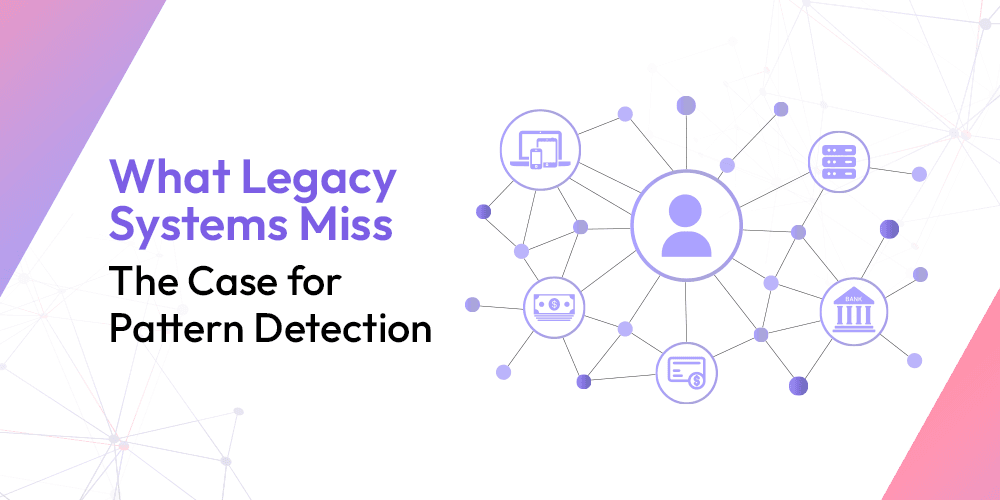
What Legacy Systems Miss: The Case for Pattern Detection
RaptorX.ai
Tuesday, June 10, 2025
The Cost of Invisibility in Financial Crime
Financial crime has evolved from opportunistic one-off incidents to highly coordinated and multi-layered operations. Fraudsters are now sophisticated actors who exploit speed, scale, and systemic gaps. For banks and financial institutions, relying solely on legacy systems built on static rules and siloed data is proving inadequate in the face of such complexity.
Where Legacy Systems Fall Short
1. Rule Dependency and Rigidity
Legacy systems typically depend on fixed, rule-based thresholds, flagging transactions only when they exceed pre-defined limits. While effective against known typologies, this approach lacks the flexibility to detect evolving, subtle fraud patterns that don't trip traditional alarms.
For instance, structuring techniques—where funds are split into small, seemingly innocuous transactions—often bypass thresholds. Similarly, activities like account layering or round-tripping remain invisible to rule-only detection engines.
2. Transaction-Centric Blindness
These systems analyze transactions in isolation. They fail to understand the context, including historical behavior, relationships between entities, or network-level patterns. As a result, potential red flags—like a dormant account suddenly initiating high-frequency transfers—go undetected unless they match a hard-coded rule.
3. High False Positives, Low Signal Quality
Without a nuanced understanding, legacy systems often generate a high volume of false positives. This not only clogs investigation pipelines but also desensitizes teams to real threats. Excessive alert noise drains analyst time and can obscure the few hazardous behaviors within a sea of benign anomalies.
The Role of Pattern Detection
A Shift from Events to Behaviors
Pattern detection reframes how institutions monitor risk, not as a set of isolated events, but as an evolving tapestry of behaviors. By observing the relationships between accounts, transaction paths, and deviations from typical behavior over time, it becomes possible to surface threats that legacy systems miss.
Examples include:
- Mule account detection through cross-account behavior mapping
- Synthetic identity use through consistent behavioral mismatches
- Collusive networks uncovered via relationship and sequence analysis
Real-Time, Multi-Dimensional Insights
Pattern-based approaches don't just look for “what happened”—they ask, “Is this expected?” and “What else is connected to this action?” This model builds a dynamic understanding of risk that adjusts to evolving behaviors and emerging threats, enabling institutions to respond earlier in the fraud lifecycle.
Challenges Addressed by Pattern Detection
Legacy Limitation:
- Uses fixed thresholds that don't adapt to changing behavior
- Relies on isolated transaction views without broader context
- Causes alert fatigue due to excessive false positives
- Requires manual rule maintenance, which is time-consuming and rigid
Addressed By Pattern Detection:
- Builds adaptive behavior baselines that evolve with user behavior
- Provides cross-entity and cross-channel context for better detection
- Delivers higher precision with fewer false positives
- Utilizes self-learning models that continuously adjust over time
Key Use Cases for Banks
- Detecting Mule Accounts: Recognizing movement patterns typical of laundering or pass-through behaviors.
- Combating Smurfing: Flagging repetitive small-value transfers within short time frames.
- Preventing Account Takeovers: Identifying shifts in device fingerprints, location anomalies, or access time patterns.
- Uncovering Fraud Rings: Mapping how seemingly independent accounts are behaviorally or financially connected.
Operational Benefits for Financial Institutions
- Focused Investigations: By lowering noise, analysts can prioritize high-risk alerts backed by contextual intelligence.
- Faster Response Time: Real-time analysis reduces lag between suspicious activity and intervention.
- Stronger Regulatory Alignment: Pattern recognition supports better justification and traceability for suspicious activity reports (SARs/STRs).
- Scalability: Unlike static rules that need continual human tuning, pattern-based detection adjusts to data growth and behavioral shifts.
Conclusion: Time to Rethink Legacy Infrastructure
As financial criminals grow more organized and less predictable, it becomes clear that yesterday’s systems weren’t built for today’s threats. Rule-based detection models, while still useful in narrow contexts, no longer offer the depth or speed required to address advanced fraud.
Institutions that integrate pattern detection not only reduce their exposure to losses, they also gain a system that learns, evolves, and responds in real time. In a world where fraud hides in patterns, recognizing those patterns isn’t just an advantage—it’s a necessity.

